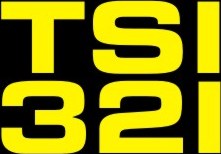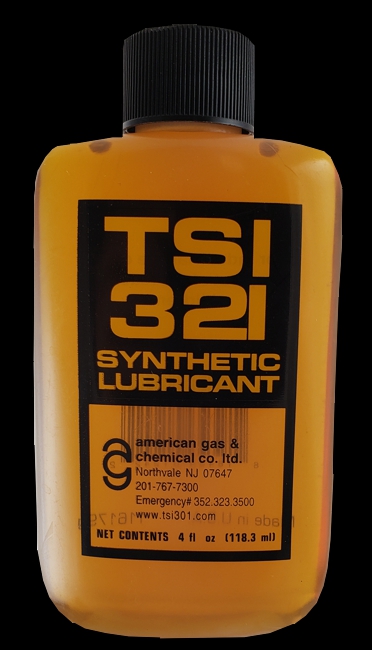TSI 321 More Information An engineering evaluation was conducted at Honeywell, Philadelphia Division. Fort Washington, Penna. to determine if TSI 321 Oil was an adequate or superior replacement for the presently specified petroleum based lubricant. The results of the tests proved conclusively that TSI 321 is an excellent lubricant with rust inhibiting and oxidation preventative properties which far excel anything that has ever been tested. Its operating range has been tentatively established at -100°F to +350°F and its lubricating qualities showed no breakdown with load, temperature or time. Its compatibilities with other lubricants is of question, as it replaces them rather than combines with them. The results of the tests were favorable and an Engineering Specification has been written approving it for general use as a single component lubricant for Honeywell, Philadelphia Division.
Background: Chemical Laboratory Examination: Compatibility TSI 321 was mixed with petroleum and Diester oils, mixing occurred without any trouble, compatibility appeared to be good. Samples of mixed oils were subjected to +450°F to -100°F, discoloration occurred but no sediments were noted. Low carbon steel gears were coated with each mixture and subjected to heat and humidity in a humidity chamber (200°F @ 100% humidity), after 48 hours no evidence of rust formation. A new batch of gears were lubricated with virgin petroleum and Diester base oils and placed in the humidity chamber under identical conditions. Rust spots were noted after 8 hours. A third batch of gears were coated only with TSI 321 and subjected to the identical humidity and temperature conditions, after 48 hours, no rust had formed. The test was terminated after 7 days, at this time the gears were examined microscopically for possible rust formation; none was found. It has been definitely proven that TSI 321 is an excellent rust preventative as well as lubricant, and when mixed with a petroleum or Diester oil it will not lose its properties to that oil. An attempt was made to mix TSI 321 with different greases; this proved unsuccessful as the TSI lubricant apparently destroyed the viscosity of the grease and the resultant mixture was turned into a slush rather than a solid grease. Attempt to lubricate gears with this mixture proved unsuccessful as the only thing that stayed on the gears was the TSI lubricant, the slush just ran off. Apparently the TSI 321 will replace the grease but no mix with it.
Gear Box Test: Six (6) motors having a 60:1 gear box were lubricated with TSI 321 and put on test. After 3 months at a temperature of 170°F, no evidence of oxidation or breakdown of lubricant was seen. Original hobbing marks were still present on the teeth. Six (6) companion motors, running along side those lubricated with TSI 321, lubricated with a conventional petroleum base Terasso lubricant, showed a brownish residue forming between the shaft and the gear. This was determined to be rust caused by the oxidation breakdown of the lubricant. Gears showed severe wear marks. These motors were kept running until the gears jammed because of the rust formation. The gear boxes were then opened up and 1 oz. of TSI 321 was injected into the jammed gears. The gear boxes were then closed up and let sit for 5 minutes. The motors were then reenergized, the initial power was high but they did not start to rotate. After 10 minutes of running, the input power was back to normal. Motors were stopped and friction torque was checked, readings indicated that the friction torque was within original specification limits. Motors were then reenergized and allowed to run for 24 hours. After the motors had run 24 hours, they were torn down and examined. The felt wicks were loaded with rust; however, there was no rust residue on the gears or shafts, these were clean and shiny. Microscopic examination revealed the rust cavities which had been formed; however, there was no rust in these cavities, nor was there any rust on any of the steel gears or shafts, even though the felt wick reservoirs were filled with rust. It appeared that the TSI 321 lubricant had stopped the rusting and lifted the rust off of the metal while coating the surface with a film which appeared to be impenetrable. This property of the lubricant to replace a petroleum base lubricant was also noted in greased packed bearing which were re-lubricated with TSI 321. Friction torque readings of the bearings under axial load were the same as bearings lubricated with TSI 321 alone. Slide Wire and Low Voltage Rotating Contact: An engineering evaluation was conducted in order to determine the affects of the TSI 321 on slide wires and rotating contact switches. Five slide wire and five rotating contact switches were lubricated, wiped with TSI 321; these were run with an equal number of virgin components. An immediate noticeable affect was that the audible noise level was greatly reduced and the signal level became more consistent, less electrical noise. It was apparent that the contacts had stopped bouncing. A stroboscopic examination revealed that the contacts had stopped bouncing and a better sliding action was observed, thus resulting in less electrical and audible noise. After 2 months @ 60 rpm, the slide wires and rotating contacts were again examined. Those lubricated with TSI 321 were clean, free of dust and oxidation contamination and showed a marked decrease of metallic residue from the sliding action. Audible and electrical noise was at the same level as originally checked. Units not lubricated with TSI 321 were full of dust and metallic residue, and were both audibly and electrically noisy. The units were kept on test for a period of four months, at this time the non-lubricated ones failed due to shorts and opens caused by the sliding friction and metallic residue. The lubricated slide wires and contacts were working perfectly. After two more months, the test was terminated. Results clearly indicated that the TSI 321 lubricant decreased significantly the audible and electrical noise on slide wires and rotating contacts and increased the life of the components. buy | back | specifications ©2025 american gas & chemical co. ltd., Northvale, NJ
|

